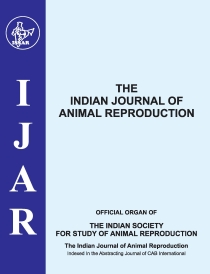Therapeutic efficacy of ozone insufflations in alleviating endometritis in cows
DOI:
https://doi.org/10.48165/ijar.2023.44.01.12Keywords:
Bacterial load, Endometritis, Ozone therapyAbstract
The present investigation was carried out to study the effect of intrauterine ozone insufflation alone or in combination with cephalexin in treating the postpartum clinical endometritis in dairy cows. A total number of fourteen postpartum clinical endometritic cows selected after screening were allotted randomly into 2 equal groups (n=7). The Group I & II cows were intrauterinely administered with ozone insufflations either alone or in combination with cephalexin (Lixen-IU®). Seven postpartum normal cyclic animals were taken as control. Following treatment the overall reduction in combined mucous character and odour both in group I (82.04%) and group II (87.25%) were similar and highly significant (p<0.01). The most predominant bacteria found was E. coli (28.57%) followed by Pseudomonas spp. (14.28%), Staphylococcus spp. (21.42%), Streptococcus spp. (21.42%), Proteus spp. (7.14%) and Acinetobacter calcoaceticus (7.14%). Overall reduction in bacterial count on pre (day 1) and post treatment (day 7) were highly significant (p<0.01) i.e. 99.60% in group I and 99.72% group II. PMN cell counts of uterine smear were significantly (p<0.01) increased from pre treatment (25.85±3.28 in group I and 22.85±2.77) in group II) to post treatment (77.71±2.86) in group I and 87.14±1.35 in group II) which indicated the infiltration of neutrophils due to action of ozone and cephalexin. The conception rates following first AI were recorded as 42.85% in group I (3/7) and 71.42% (5/7) in group II. Thus intrauterine ozone insufflation has the potential to alleviate postpartum clinical endometritis as an efficacious, cost effective treatment option and an alternative to antibiotics with an overall improvement of fertility rate in dairy cows.
References
Constantin, T. and Birtoiu, I. A. (2016). Preliminary Study on Ozone Therapy in Postpartum Endometritis of Dairy Cows. Agric. Agric. Sci. Procedia, 10: 384-389.
Dhaliwal, G. S., Murray, R. D. and Woldehiwet, Z. (2001). Some aspects of immunology of the bovine uterus related to treat ments for endometritis. Anim. Reprod. Sci., 67: 135-152.
Djuricic, D., Valpotić, H. and Samardzija, M. (2015). The intra uterine treatment of retained foetal membrane in dairy goats by ozone: novel alternative to antibiotic therapy. Reprod. Domest. Anim., 50: 236-239.
Elvis, A. M. and Ekta, J. S. (2001). Ozone therapy: A clinical review. J. Nat. Sci. Biol. Med., 2: 66-70.
Kumar, P., Srivastava, S. K., Rawat, M., Yadav, M. C. and Kumar, H. (2004). Effect of certain immunomodulators on uterine infections and fertility in postpartum buffaloes. Asian Aust. J. Anim. Sci., 17(7): 930-935.
Malik, B. S. (1967). Laboratory manual for bacteriology and immunology. 1st Edn. British book depot, Lucknow. Pradhan, K. C., Mishra, P. C., Mohanty, D. N. and Panda, S. K. (2014). Use of certain hormonal tocolytic agents in bovine endometritis. M.V.Sc. Thesis submitted to Orissa University of Agriculture and Technology, Bhubaneswar, Odisha. Prunner, I., Pothmann, H., Wagener, K., Giuliodori, M., Huber, J., Ehling-Schulz, M. and Drillich, M. (2014). Dynamics of bacteriologic and cytologic changes in the uterus of post partum dairy cows. Theriogenology, 82: 1316-1322. Rao, K. S., Raju, K. G. S. and Reddy, V. S. C. (2001). Comparative efficacy of mycosal with or without prostaglandin F2α in endometritis buffaloes. XVI Annul. Conv. Natl. Symp., ISSAR Ranchi, 60.
Scrollavezza, P., Ablondi, M., Pogliacomi, B., Guareschi, D., Dall’aglio, R. and Poldi, R. (1997). Ozone treatment in mas tites, metrites and retention of fetal membranes in the cows. Atti 2°Intern. Symp. Ozone Application, Havana, Cuba.
Sheldon, I. M., Lewis, G. S., LeBlanc, S. J. and Gilbert, R. O. (2006). Defining postpartum uterine disease in cattle. Theriogenology, 65: 1516–1530.
Singh, H., Dua, K., Randhawa, C. S. and Singh, P. (2000). Haematology of buffalo around parturition. Indian J. Vet. Med., 20: 83-84.
Singla, P., Singh, J., Sharma, N. S., Dhaliwal, G. S. and Kumar, A. (2004). Effect of post AI immune therapy on dynamics of uterine microflora and conception in subclinical endome tritis. Indian J. Anim. Sci., 7: 706-709.
Turk, R., Samardžija, M. and Bačić, G. (2011). Oxidative stress and reproductive disorders in dairy cows. In: Dairy Cows: Nutrition, Fertility and Milk Production, (Marek, E. R., Ed.). New York: Nova Science Publishers, p. 57-98.
Williams, E. J., Fischer, D. P., England, G. C. W., Dobson, H., Pfeiffer, D. U. and Sheldon, I. M. (2005). Clinical evalua tion of postpartum vaginal mucus reflects uterine bacterial infection and the inflammatory response to endometritis in cattle. Theriogenology, 63: 102–17.
Zerbe, H., Obadnik, C., Leibold, W. and Schuberth, H. J. (2002). Lochial secretions of Escherichia coli or Arcanobacterium pyogenes- infected bovine uteri modulate the phenotype and the functional capacity of neutrophilic granulocytes. Theriogenology, 57: 1161-1177.
Zerbe, H., Schneider, N., Leibold, W., Wensing, T., Kruip, T. A. and Schuberth, H. J. (2000). Altered functional and immunophenotypical properties of neutrophilic gran ulocytes in postpartum cows associated with fatty liver. Theriogenology, 54: 771-786.
Zobel, R., Martinec, R., Ivanović, D., Rošić, N., Stančić, Z., Žerjavić, I., Flajsig, B., Plavec, H, and Smolec, O. (2014). Intrauterine ozone administration for improving fertility rate in Simmental cattle. Vet. Arhiv., 84 (1): 1-8.




